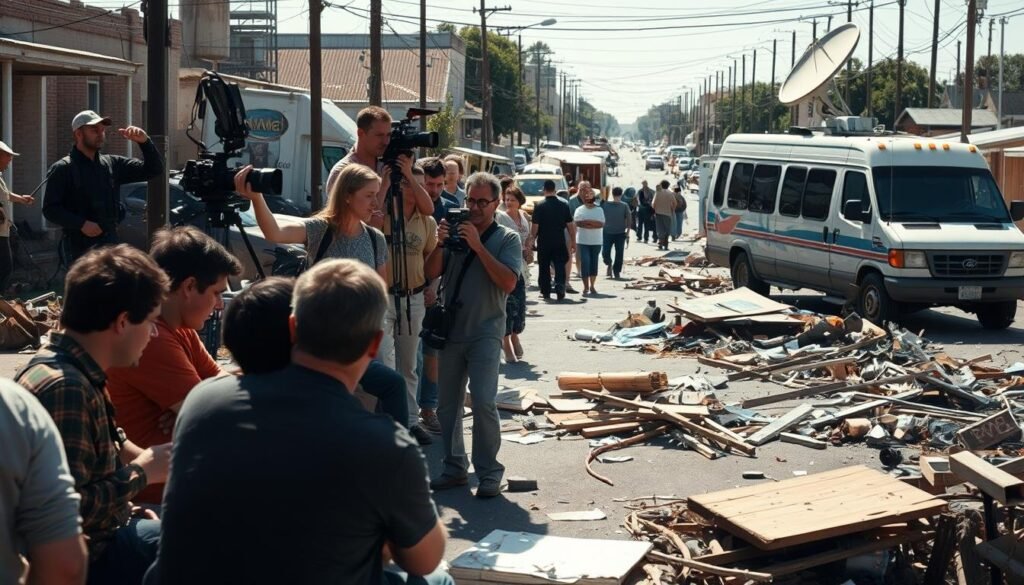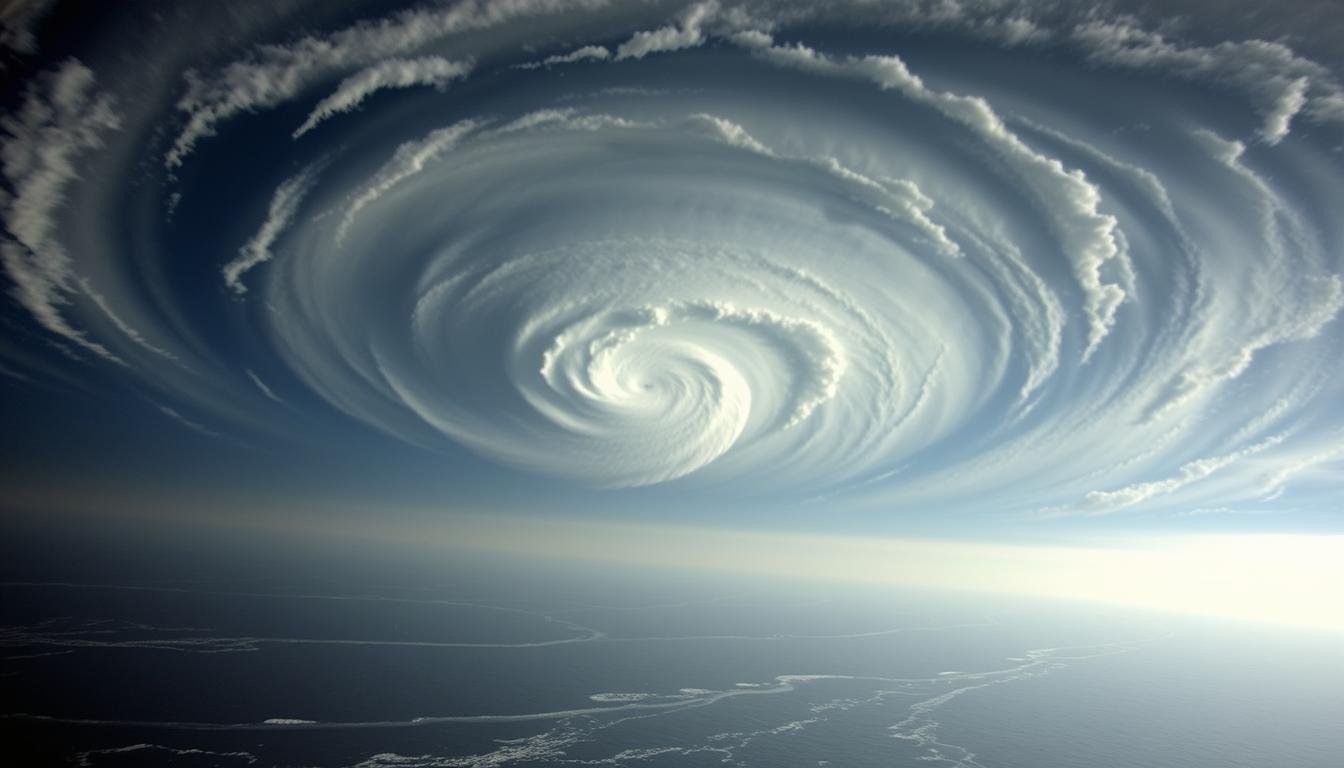Challenges Did President Bush Face in August 2005: In August 2005, President Bush faced a major crisis. Hurricane Katrina hit the Gulf Coast, especially New Orleans, hard.
The storm’s impact was huge, causing a lot of damage and flooding. Levees failed, flooding New Orleans and displacing many. This led to a big loss of life.
President Bush had to deal with many challenges. He had to respond quickly, provide aid, and help with recovery. The response to Hurricane Katrina in August 2005 shows the tough side of leadership and crisis management.
Contents
- 1 The Political Landscape Before August 2005
- 2 What Challenge Did President Bush Face in August of 2005: Hurricane Katrina
- 3 Federal Emergency Management Failures
- 4 Media Coverage and Public Reaction
- 5 Other Significant Challenges in August 2005
- 6 Conclusion: Challenges Did President Bush Face in August 2005?
- 7 FAQ
- 7.1 What were the main challenges faced by President Bush in August 2005?
- 7.2 How did Hurricane Katrina impact President Bush’s presidency?
- 7.3 What was the “Heckuva Job, Brownie” moment, and why is it significant?
- 7.4 How did the media coverage of Hurricane Katrina affect public reaction?
- 7.5 What were some of the other significant challenges President Bush faced in August 2005?
- 7.6 How did the political landscape before August 2005 influence President Bush’s decisions?
The Political Landscape Before August 2005
In the years leading up to August 2005, the political landscape was crucial for President Bush. You might have noticed the challenges he faced. But knowing the background is essential.
Several factors shaped the political climate:
- The ongoing Iraq War was a major point of contention.
- President Bush’s approval ratings were falling.
- Concerns about the federal budget and spending were growing.
When looking at President Bush‘s decisions before August 2005, the pre-August 2005 political scene is key. Domestic and international pressures made it a complex time.
The main issues for President Bush included:
- Managing the Iraq War’s impact on domestic policy.
- Dealing with criticism of his administration’s crisis handling.
Knowing these factors helps us understand the challenges President Bush faced in August 2005.
What Challenge Did President Bush Face in August of 2005: Hurricane Katrina
Hurricane Katrina hit in August 2005, testing President Bush’s leadership. The storm’s approach showed the importance of government readiness. Preparations and responses at all levels were key.
Early Warning Signs and Preparations
Forecasters warned of a catastrophic storm before Katrina landed. The National Hurricane Center issued timely warnings. Emergency teams started preparing, but their efforts varied.
Evacuation Orders and Compliance
As Katrina approached, evacuation orders were given for parts of Louisiana, Mississippi, and Alabama. Many left, but others stayed, posing challenges for emergency teams. This situation had a big impact later.
The New Orleans levee system failed, causing massive flooding. This displaced hundreds of thousands and damaged property. It showed the city’s infrastructure weaknesses.
Devastation Across Mississippi and Alabama
Katrina also hit hard in Mississippi and Alabama. Coastal areas suffered from storm surges, destroying homes and businesses. The disaster needed a big federal response.
Bush’s Activities During the Crisis
President Bush visited affected areas, meeting with officials and seeing the damage. His team tried to coordinate relief efforts. However, the response was slow and not enough for some.
The “Flyover” Controversy
President Bush was criticized for flying over the damage in Air Force One. It seemed he was out of touch with the ground’s suffering. This moment is still debated about his Katrina response.
In conclusion, Hurricane Katrina was a huge challenge for President Bush in August 2005. It showed problems in disaster readiness, response, and recovery. It also changed how the nation handles such crises.
Federal Emergency Management Failures
The response to Hurricane Katrina showed big weaknesses in federal emergency management. When Katrina hit in August 2005, FEMA’s problems were clear. The storm’s impact on the Gulf Coast, especially New Orleans, was huge. The disaster response was slow, with bad communication and poor coordination among agencies.
FEMA faced criticism before Katrina. The agency had changed a lot in the years before 2005. It moved towards handling all kinds of disasters, but this caused confusion in how it responded.
| Issue | Description | Impact |
|---|---|---|
| Lack of Clear Protocols | Unclear procedures for disaster response | Delayed Response |
| Insufficient Training | Adequate training not provided to personnel | Ineffective Response Efforts |
| Poor Coordination | Lack of coordination among agencies | Confusion and Delays |
The “Heckuva Job, Brownie” Moment
The phrase “heck of a job, Brownie” became infamous. President Bush praised FEMA Director Michael Brown during a press conference. This was seen as insensitive, given the disaster’s scale and the response failures.
The Katrina failures showed the need for change. Afterward, FEMA’s structure and procedures were overhauled. These changes aimed to improve disaster response. Understanding these failures helps us see the importance of good coordination and preparation in emergency management.
Media Coverage and Public Reaction
You saw Hurricane Katrina’s impact through the media. The storm hit on August 29, 2005. News showed the damage to New Orleans and the Gulf Coast non-stop.
The media showed the hurricane’s power and the government’s slow response. Pictures of flooded streets and people in need filled the news. This made many Americans angry and disappointed with the government’s actions.
| Media Coverage Aspect | Public Reaction |
|---|---|
| Images of devastation | Shock and empathy for victims |
| Criticism of government response | Outrage and demand for accountability |
| Personal stories of survivors | Humanization of the disaster’s impact |
People quickly called for investigations into the disaster’s handling. The media kept telling the stories of those affected and the recovery efforts. It showed that Katrina was not just a natural disaster, but also a test of government readiness.

The media’s role in shaping public opinion was huge. It brought the disaster’s reality to everyone. Looking back at August 2005, the media and public reaction changed how the U.S. handles disasters.
Other Significant Challenges in August 2005
President Bush faced many challenges in August 2005, not just Hurricane Katrina. The month was filled with complex issues that tested the administration’s ability to respond.
Rising American Casualties
The Iraq War was getting worse, with more American soldiers dying. In August 2005, the U.S. military lost a lot of lives. This made people question the war more.
Growing Anti-War Sentiment
As more soldiers died, more Americans started to oppose the war. They held protests and demonstrations. This added more pressure on the Bush administration.
Hurricane Katrina also hurt oil production and refining. This caused gas prices to go up. Americans had to pay more for fuel.
Consumer Confidence Issues
The high gas prices and the war in Iraq hurt consumer confidence. People were worried about the economy. They lost trust in it.
| Challenge | Description | Impact |
|---|---|---|
| Rising American Casualties | Increased military losses in Iraq | Eroded public support for the war |
| Growing Anti-War Sentiment | Escalating protests and demonstrations | Added pressure on the Bush administration |
| Post-Katrina Gas Price Spikes | Disruptions in oil production and refining | Higher fuel costs for consumers |
| Consumer Confidence Issues | Economic uncertainty due to gas prices and the Iraq War | Decline in consumer trust in the economy |
In summary, August 2005 was tough for President Bush. He faced the human cost of the Iraq War and economic worries at home. Knowing about these challenges helps us understand the tough times of that period.
Conclusion: Challenges Did President Bush Face in August 2005?
August 2005 was a tough time for President Bush, especially with Hurricane Katrina. This disaster hit the Gulf Coast hard, especially New Orleans. It showed big problems with how the government handled emergencies.
The slow response to Katrina hurt many people and damaged President Bush’s image. The media and public were very critical. This made people lose trust in the administration.
In August 2005, President Bush faced big challenges, including Katrina. His leadership was tested. The way he handled these crises lowered his approval ratings and changed his presidency.
See Also: Why Was John Quincy Adams Unpopular?
FAQ
What were the main challenges faced by President Bush in August 2005?
President Bush had to deal with many big issues in August 2005. Hurricane Katrina was a major one. He also faced rising casualties in Iraq and growing opposition to the war.
Gas prices went up after Katrina, affecting people’s confidence. These problems made it tough for President Bush.
How did Hurricane Katrina impact President Bush’s presidency?
Hurricane Katrina hit President Bush’s presidency hard. It showed the government’s failure in emergency management. This made people question his leadership.
It also hurt his approval ratings. The disaster’s impact was huge.
What was the “Heckuva Job, Brownie” moment, and why is it significant?
The “Heckuva Job, Brownie” moment was when President Bush praised FEMA Director Michael Brown. It was seen as insensitive to the disaster’s severity.
This moment was widely criticized. It showed a disconnect between the government’s response and the people’s needs.
How did the media coverage of Hurricane Katrina affect public reaction?
Media coverage of Hurricane Katrina changed how people felt. The reports of the disaster’s damage and slow government response made people angry.
It led to more criticism of President Bush’s administration. The media played a big role in shaping public opinion.
What were some of the other significant challenges President Bush faced in August 2005?
Besides Katrina, President Bush had other big challenges. Rising casualties in Iraq and growing opposition to the war were big issues.
Gas prices also went up, affecting people’s confidence. These problems made it hard for President Bush to manage his presidency.
How did the political landscape before August 2005 influence President Bush’s decisions?
The political scene before August 2005 shaped President Bush’s actions. The Iraq War and political divisions were key factors.
These influenced how he handled Hurricane Katrina and other challenges. The political landscape played a big role in his decisions.

Hi, I am Tatum Bradford from Washington. I have a background in political science and work as a senior revenue officer. I love learning about U.S. presidents and sharing interesting facts about political history.

